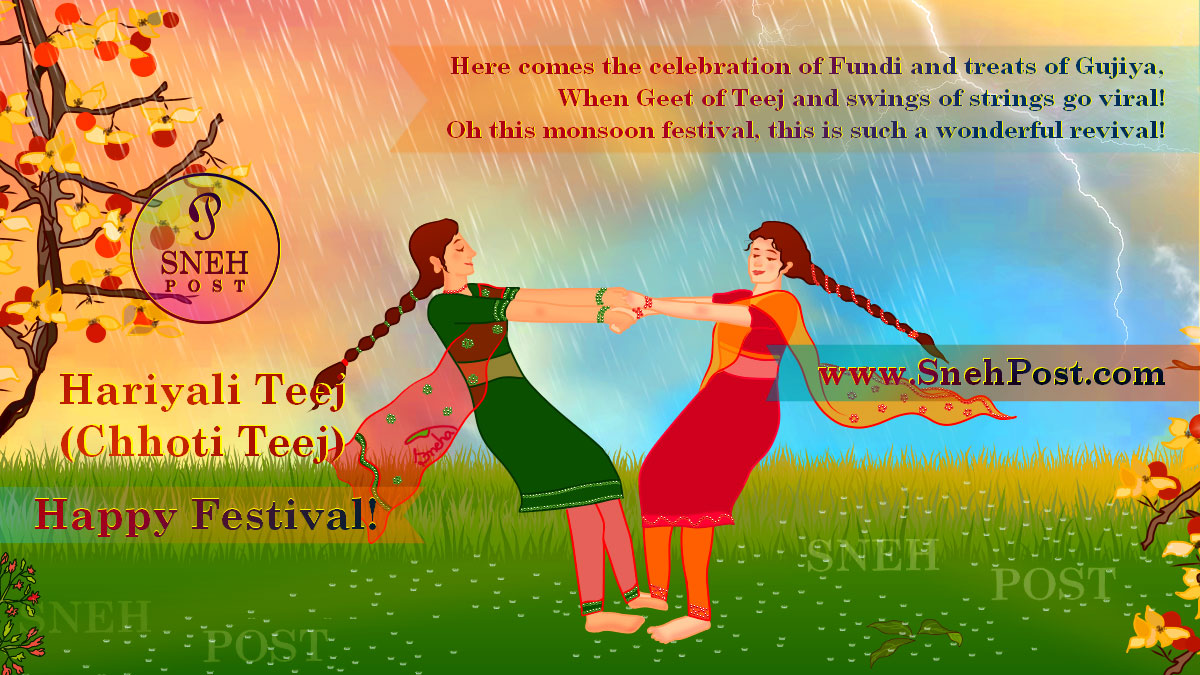Hariyali Teej, also known as Shravan Teej and Chhoti Teej, is a Hindu festival that is celebrated during Monsoon. Where Kajari Teej is significantly observed by married women, Hariyali Teej is for unmarried girls.
One of Teej festivals, Hariyali Teej is famous among the Indian ladies in Madhya Pradesh, Uttar Pradesh, Jharkhand, Bihar, and North Indian states such as Rajasthan. Other Teej festivals that people enjoy celebrating are Kajari Teej (Badi Teej or Satudi Teej), Hartalika Teej, Akha Teej (Akshay Tritiya), and Gangaur Tritiya.

Here comes the celebration of Fundi and treats of Gujiya,
When Geet of Teej and swings of strings go viral!
Oh this monsoon festival, this is such a wonderful revival!
Preview
About Hariyali Teej: Who Celebrates Hariyali Teej?
Ideally, Hariyali Teej rituals are performed by unmarried Hindu girls. Married females also participate in Teej Puja (worship) though.
After fifteen days of Hariyali Teej, Kajri Teej (Also known as Badi Teej) is celebrated.
Date and Time of Hariyali Teej Observance: When is Hariyali Teej in 2021?
As per the Hindu calendar Panchang, Hariyali Teej falls on Shravana Shukla Tritiya. It means — the Tritiya tithi (third date) of the month of Shravana during the Shukla Paksha (moon’s bright phase).
As they coincide with the monsoon, Savan, or Varsha Ritu, they hold a special place in the hearts of the women folks.
Hariyali Teej in Upcoming Years
Hariyali Teej Celebration: How is Hariyali Teej Celebrated?
Preparations (Preliminary Activities) of Hariyali Teej
Girls Apply Henna on Hands
Some follow this as a tradition and others as a ritual. There is no strong or famous mythology to back this observation of applying henna on hands before the day of Teej though.
In Hinduism, Mehendi (henna) is used for beautification and embellishment. Both married girls and unmarried women apply its beautiful designs.
Steps of Applying Mehandi (Henna)
- First of all, after purchasing henna powder, it is filtered through a cotton cloth. This step helps in getting rid of the clusters in henna powder. The lumps remain in the cloth and we get the ready-to-use powder.
- In the next step, henna meets the water that is added spoon-by-spoon and then drop-by-drop for making a perfect paste. This step provides is a fine paste. Its consistency ensures finesse in the making of the design.
- It is not used instantly. The paste is kept for some hours so that it gives strong color to hands later.
- After keeping it to rest for some hours, the Mehandi cones are made with poly-bags. And thus you get the tool to make your designs.
- After applying on hands, the hennaed hands are kept sophisticatedly for 7 to 8 hours. When it dries up, females remove it.
The colorful hands are ready to flaunt.
The henna-applying program takes place a day before Teej. Usually, females apply it at night and remove it the next morning.
Rope Swings
Women prepare swings these days and enjoy swinging in pairs with their female friends, relatives, or neighbor ladies.
Things to Collect for Hariyali Teej Worship
Females do not perform worship rituals the way they do on Kajari Teej (Also known as Chhoti Teej). They just visit a nearby temple to worship Lord Shiva and Parvati for seeking their blessings.
For worship rituals, they embellish their Puja Thaal with the mixture of milk and water, kumkum (sindoor — red colored powder), rice, lachha (roli — sacred thread), flowers (specifically from the plants of aankde), fruits, sweet, etc.
Their are some places such as Jaipur city in Rajasthan where Hariyali Teej or Chhoti Teej is celebrated as Kajari Teej. Married ladies also follow all the rituals on this day only. They do not observe Badi Teej that comes some days later on Bhadrapada month's third day.
Hariyali Teej (Puja Vidhi): Method of Hariyali Teej Worship
Females offer water, milk, flowers, and all the other stuff one-by-one with great devotion to their diety.
We will gather information on the detailed worship rituals that ladies perform with Neem in the article on Kajri Teej (Badi Teej).
Hariyali Teej Katha
Those ladies who perform all the Kajari Teej's rituals on this Teej's day, they also narrate some stories to build up faith. The stories feature Teej Mata and Neem (Neemdi) and revolves around one or two females and their journies of faith. The popular stories remain:
- The story of a moneylender who deviates from the path of righteousness and falls into wrong practices. His wife keeps praying walking on the straight path. Eventally, Teej Mata (Mother Parvati) turns her husband's heart and restores what they loose.
- Another story belongs to two sisters. One speaks bitter words about the taste of Neem. As per her views about Neem, her words also seem bitter to other people. Later, she gets to know about it from her sister and changes her words. It results into restoration of sweetness into her words.
- The third story belongs to a lady and her daughter-in-law. The lady makes covenents with Neem for seeking the blessing of a boy for daughter-in-law, then later, for marriage of her daughter. She also declares to offer laddu (sweet) to the Neem if her wishes gets fulfilled. But when it all happens, she forgets about the offerings. Later, when she tries to offer her worships again, Neem goes away of her. Some nearby ladies suggests her to fullfill her declarations and so she does.
- Ladies also narrate the story of Lord Ganesh among each other to make the number of stoies "four".
Hariyali Teej Rituals: How is Hariyali Teej Celebrated?
Sindhara (Sinjara)
The word Sindhara has come up from the word “Singar”. Earlier, it was also known as “Singara” that means “Shringar” or adornments that enhances the beauty of a female. In Indian traditions, a married female dons 16 Shringar items (ideally).
In Case of Single Girls
The traditions of Sinjara are not followed when it is about single, unmarried girls. It is observed with the married ladies.
In Case of Married Ladies
The in-laws gift their daughter-in-law Sinjara — the Shringar items (beauty adornments such as henna, bangles, clothes, etc.). Along with them, they also present sweets, fruits, and dry fruits to their daughter-in-law.
Sinjara is given a day before Teej so that the females can wear the gifted dress on the day of Teej and enjoy the sweets on the festival’s day.
Ladies go to their parent’s home on this occasion. When they come back, their parents send also send her with Sinjara for their daughter’s in-laws.
In Case of Would-Be-Brides or Girls to Marry Soon
If a girl’s marriage gets fixed with someone, then also the tradition of Sinjara is followed. The would-be bride receives gifts or Sindhara from her would-be in-laws on Chhoti Teej.
Musical Celebrations
Females come along in a get-together for singing geet (regional or folk songs), playing the classical music instruments such as Tabla, dancing, and enjoying Foondi (having hands in the cross and taking rounds together).
Fasting on Hariyali Teej
Single or unmarried Hindu girls keep fast and seek blessings of finding a righteous groom or perfect match of their choice.
Offerings/Donation on Hariyali Teej
Sinjara also incorporates sweets, especially Ghevar — an Indian sweet, as a prime sinjara item. People gift more as a daan-punya act so that the sweet can also be distributed among the neighbor females.
Hariyali Teej Uddhyapan
Those females who take the resolution of keeping fast on Teej, if they want to discontinue to keep fast, they do uddhyapan of the series. Though they can keep fast even after that too, if they want.
Usually, unmarried girls do not do uddhyapan of Teej. They do it after marriage. They perform Teej Uddyapan rituals on Kajari Teej as it is specially observed by the married Hindu ladies.
However, Indian ladies who observe the Teej falling in Shravana month only, they perform Teej Uddhyapan on Chhoti Teej (Hariyali Teej).
Why is Hariyali Teej Celebrated?
As Hariyali Teej, the festival of celebrating the spring, also symbolizes their reunion, females worship them together for the blessing of happy married life and conjugal bliss.
Legends of Hariyali Teej Festival: God and Goddess People Worship on Hariyali Teej
Who is Worshipped on Hariyali Teej?
Hindu Goddess Parvati is prayed on Hariyali Teej. The devotee girls also worship Lord Shiva along with Parvati Maa.
Where is Hariyali Teej Celebrated?
Countries such as Nepal and India where Hindus are more in number are more into observing the Teej festival and its traditions.
The festival of Teej and traditions associated with it are popularly observed in countries like India and Nepal. In North India, religious females do perform Teej rituals. However, Hindu people who are living outside India also observe Teej traditionally.
Interesting Facts about Hariyali Teej
Only Females Are Allowed
Teej is totally a females-oriented festival. Only girls and married females participate in it, not males.
Shopping on Teej
The preparations of Teej festival begins many days before. The highlights remain the shopping of females. It includes the purchasing of makeup products, jewelery, and other things that can be used for the beautification.
Get Together of Girls and Married Females for Teej
Despite the obvious above fact that gives us glimpse why females celebrate Teej festivals with great joy, it can't be denied their center of attraction remains the get-together with other ladies. It's fun and exciting to witness the way different ladies don and carry their shringar (adornments and makeup).
Teej: The Monsoon Festival of Swings and Fundi
One more reason behind the happiness remains — Teej jhule (swings) and fundi (a kind of game that two females play in which they hold the hands of each other in cross and take rounds).








